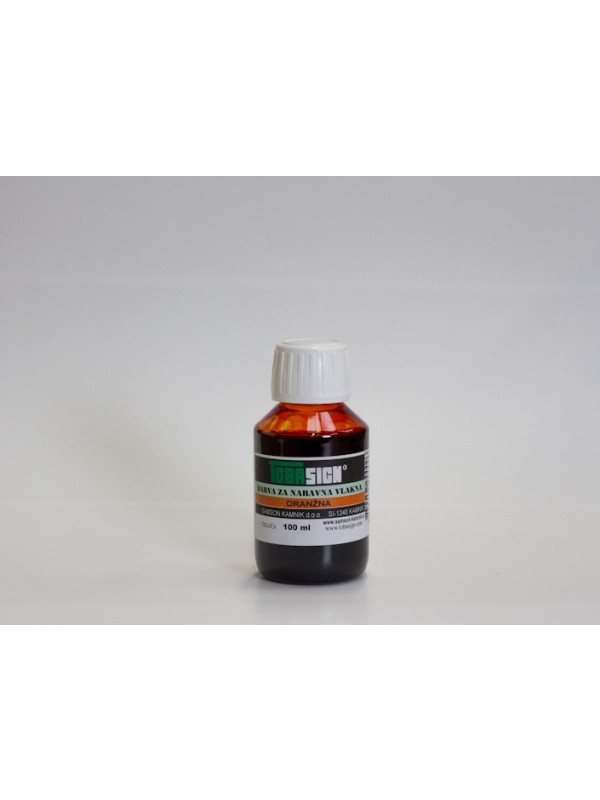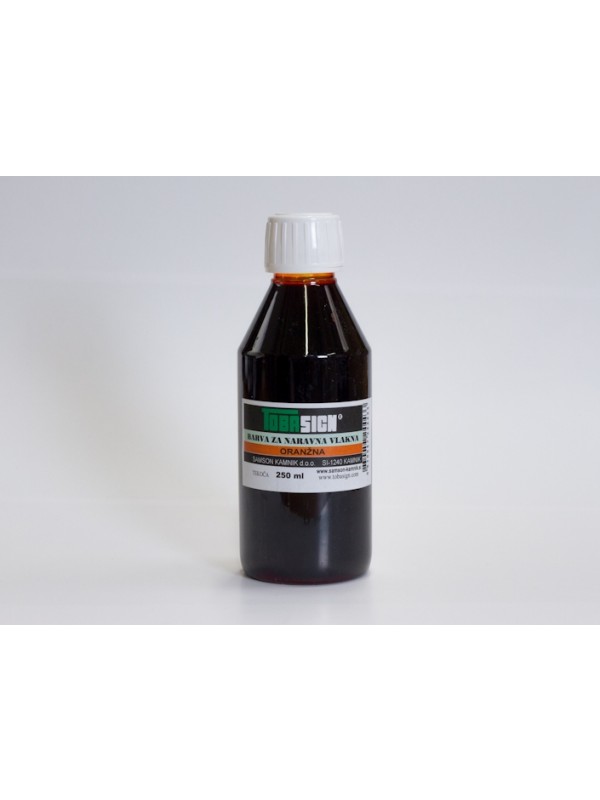TOBA SIGN ORANGE
| TOBA THIX 50 ml (thickened) |  | 3,60 € | ADD TO CART | |
| 100 ml |  | 3,42 € | ADD TO CART | |
| 250 ml |  | 6,83 € | ADD TO CART | |
| 1 litre |  | 18,30 € | ADD TO CART | |
| 5 litres |  | 59,48 € | ADD TO CART |
COLORS FOR 100% NATURAL FIBERS
Tobasign liquid colors are intended for painting and dyeing 100% natural fibers such as silk, cotton, wool, linen,...
TOBAWET is suitable for diluting Tobasign colors and achieving lighter shades or special effects.
TOBAGUT are concentrated colors for drawing lines, patterns, and separating fields with different colors.
TOBAFIX is used for fixing Tobasign colors.
Tobasign is a reactive dye in liquid form. The dye binds chemically to the fiber molecules. In this way, the dye remains in the fibers. The strong bond between these substances results in excellent wash fastness and light fastness, without changing the quality and feel of the individual fabric.
Dyeing is also possible by soaking.
Tobasign colors can be fixed in various ways:
- with Tobafix fixing agent
- with steam
- with salts Sodium chloride, alum, ...
DYEING PROCESS WITH TOBASIGN COLORS
DRAWING AND DYEING FABRIC
Painting or dyeing with reactive dyes occurs in three stages:
1. absorption of the dye into the fabric,
2. fixing these dyes in the fabric, and
3. rinsing out excess and unfixed dye.
1. Application and absorption of TOBASIGN liquid colors
When applying Tobasign colors to the fabric, you can observe how the color flows in all directions. The speed and type of color flow depend on the quality and thickness of the fabric. It is important that it is 100% natural materials (silk, cotton, linen, wool...). The fabric must not have finishes and oils that would repel water. The color can be applied in various ways: with a brush, with foam rubber brushes, with an airbrush...
The colors mix perfectly with each other, either beforehand or on the fabric itself.
TOBAWET is used to lighten Tobasign colors.
TOBAGUT is used for drawing contours and separating fields that will be differently colored. Reserve areas are created with colorless gutta, which prevents the leaking color from one field to another.
Apply and dry the contours, color the limited fields with different colors, and dry. Fix the color with TOBAfix fixing agent.
Remove Tobagut by washing with water after fixing the color. The gutta disappears, and the areas that were previously covered by gutta are once again covered with the color you were working with.
2. Fixing with TOBAFIX
After dyeing, allow the fabric to dry. Then proceed to fixing, where the color penetrates the fibers of the fabric and is fixed there. It is recommended to leave the product on the frame during fixing. Applying Tobafix is easy. The fixing agent is applied with a rubber brush. It is especially important that all colored parts are covered.
For dyeing thicker fabrics, it is recommended to apply Tobafix on both sides of the fabric.
The color is fixed in the fabric after 1 hour. Note: Tobafix can only be used for fixing Tobasign colors. Depending on the fabric, Tobasign colors fix differently:
- on silk, they can be fixed with both Tobafix and steam (with the same result);
- on cotton and linen, colors can only be fixed with Tobafix.
- on wool, colors are fixed only with steam.
3. Rinsing
After fixing, the fabric must be rinsed with water until there are no more residues of the fixing agent and the fabric no longer releases color.
If the water is colored, this is not a cause for alarm. The fibers of the fabric cannot absorb unlimited amounts of dyes and consequently release the amount of dye that is excess and not fixed.
DYEING BY SOAKING AND IN THE WASHING MACHINE
Fabric ratio: water = 1:20
(100 gr of fabric: 2 liters of water)
TOBASIGN:
50 ml - 100 ml / 1 liter of water
Depending on how intense you want the color
Kitchen salt: 50 gr / liter of water
TOBAFIX:
50 ml/ liter of water for cotton and linen
25 ml / liter of water for silk
DYEING IN THE WASHING MACHINE
1. Absorption of Tobasign color
- Weigh the fabric and calculate the amount of salt, TobaSign, and TobaFix according to the above recipe.
- Pour salt into the washing machine.
- Add the fabric you want to dye to the washing machine.
- Set the washing machine to the main wash, without pre-wash at 30°C and start the machine.
- Add the calculated amount of TobaSign to the detergent drawer. The machine should run for 15 minutes.
2. Fixing the color
Add the calculated amount of TobaFix fixing agent and let the machine go through the entire washing program. TobaFix should work for at least 1 hour. Care must be taken that the water is not rinsed before this time. If necessary, the washing cycle should be extended.
3. Rinsing
After dyeing, wash the fabric with a neutral detergent through the complete washing cycle.
Some tips for dyeing with a washing machine:
For even dyeing, choose a program with the maximum possible amount of water.
Do not overload the washing machine.
For dyeing smaller amounts of fabric, choose a program with a smaller amount of water.
DYEING WOOL
Wool ratio: water = 1:10
(100 gr of fabric: 1 l of water)
TOBASIGN:
50 ml - 200 ml / 1 liter of water
Depending on how intense you want the color
Colors can be mixed to get new shades.
Salt: 50 gr / liter of water
Weigh the fabric and calculate the amount of salt, water, and dye. Dissolve the salt in water and add the dye. The intensity of the color depends on the dilution. Soak the wool in the solution and let it soak for at least 2 hours. You can also leave it longer.
After soaking, the fabric must be rinsed with water until the fabric no longer releases color. If the water is colored, this is not a cause for alarm. The fibers of the fabric cannot absorb unlimited amounts of dyes and consequently release the amount of dye that is excess and not fixed.
After dyeing, wash the wool with a neutral detergent through the complete washing cycle or by hand.








